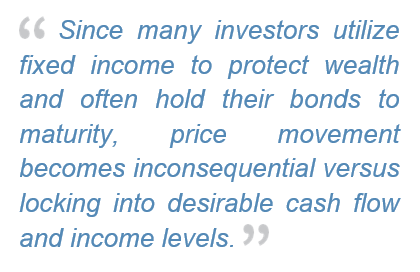A volatile year with a silver lining
- 12.04.23
- Markets & Investing
- Commentary
Doug Drabik discusses fixed income market conditions and offers insight for bond investors.
We’re in the final month of 2023 and what a wild ride it has been. The financial markets, investor opinions, and world events have been all over the place – so bear with me this morning as I am going all over the place with a variety of year-to-date observations and comments.
Interest rates have experienced wide-ranging levels. For example, the 10-year Treasury’s peak daily closing rate of 4.98% (10/19/23) is countered by its lowest close of 3.30% (04/05/23). This 168 basis point (bp) variance translates to over a 5 ¼-point price movement. This large interest rate move accentuates the mixed consumer market views revealed throughout the year. The 10-year Treasury currently sits at 4.25% which is a level higher than it has been in over 16 years. So despite the commotion and currently being off the peak rate, on a relative basis, the bigger picture view tells me it still is a good time to lock into income.
I sometimes hear investors speak of dollar cost averaging their fixed income portfolio. This term is most often associated with stocks largely because they rely heavily on price appreciation to generate income. Since many investors utilize fixed income to protect wealth and often hold their bonds to maturity, price movement becomes inconsequential versus locking into desirable cash flow and income levels. The benefit of protecting wealth exists in any interest rate environment but the additional income offered today hasn’t been seen in over 16 years.
Additionally, I’ve heard the expression “hedging our position” with a maturity mix or staying short to be conservative. Staying short is not conservative, it is an interest-rate call. By staying short, reinvestment risk rises. In other words, as maturities occur, the money is put back into the market in at-the-moment rates. It is a daring investment-timing move to purchase short-maturity bonds if it is believed that interest rates have a higher probability of moving down.
Inflation started the year at 6.4% (CPI YoY Index) and is currently at 3.2%. The Federal Open Market Committee has raised the Fed Funds rate four times by 25bp this year, pushing the Fed Funds rate to 5.50%. Much of the most recent market volatility is associated with the assumption that the Fed is done raising rates. When inflation comes down, prices are not coming down – they just aren’t rising as fast as they were. It could be viewed that the damage is done until disposable income catches up to the higher cost of goods and services.
This is where the debate about an impending recession begins to get tricky. Consumer spending accounts for roughly 70% of the U.S. economy. Some will say that as long as consumers have jobs, they will spend money. However, is the money being spent earned dollars or borrowed dollars? The average person’s mainstay wealth is in their home’s equity. This is locked in with scarcely moving real estate stymied by high interest rates. Credit card debt is rising to unprecedented levels. Payments on student loans and rents can no longer be deferred. Government handouts have dried up. Can the market sustain the current course?
The debates will continue but the one known reality of all this mayhem is the interest rate story (the silver-lining). Income levels not seen in 16+ years are available to investors. Maximize the opportunity while it exists.
The author of this material is a Trader in the Fixed Income Department of Raymond James & Associates (RJA), and is not an Analyst. Any opinions expressed may differ from opinions expressed by other departments of RJA, including our Equity Research Department, and are subject to change without notice. The data and information contained herein was obtained from sources considered to be reliable, but RJA does not guarantee its accuracy and/or completeness. Neither the information nor any opinions expressed constitute a solicitation for the purchase or sale of any security referred to herein. This material may include analysis of sectors, securities and/or derivatives that RJA may have positions, long or short, held proprietarily. RJA or its affiliates may execute transactions which may not be consistent with the report’s conclusions. RJA may also have performed investment banking services for the issuers of such securities. Investors should discuss the risks inherent in bonds with their Raymond James Financial Advisor. Risks include, but are not limited to, changes in interest rates, liquidity, credit quality, volatility, and duration. Past performance is no assurance of future results.
Investment products are: not deposits, not FDIC/NCUA insured, not insured by any government agency, not bank guaranteed, subject to risk and may lose value.
To learn more about the risks and rewards of investing in fixed income, access the Financial Industry Regulatory Authority’s website at finra.org/investors/learn-to-invest/types-investments/bonds and the Municipal Securities Rulemaking Board’s (MSRB) Electronic Municipal Market Access System (EMMA) at emma.msrb.org.



